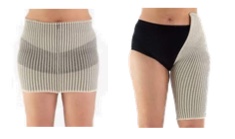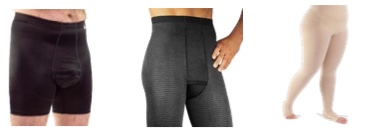GENITAL LYMPHOEDEMA – A COMPRESSION CHALLENGE - Graham Rooms
"I was diagnosed with genital lymphoedema just over 2 years ago following prostate cancer surgery. From the start I was told it was one of the most difficult areas to treat as the balance between effective compression and comfort was difficult. After two years of trying numerous garments during various activities and scenarios I can now relate to the problem, especially as a man that has some bits and bobs that do not like being compressed!
Genital lymphoedema relates to swelling in the genitals (penis, scrotum) and pubic area which often spreads to the upper thighs. In most cases this type of lymphoedema is associated with cancer surgery (ovarian, cervical, prostate) where inguinal lymph nodes are dissected to assess cancer spread.
Although compression is the first line of treatment for upper/lower limb lymphoedema it is a far greater challenge when dealing in areas where there is no natural core that can support compression.
My journey for finding the right compression garment to control my genital swelling, especially in my pubic area has been far and wide. I have purchased numerous off the shelf compression shorts and hernia pants, been issued a variety medically graded styles, and even tried compression tights. In combination with these I have used padding and foam in various densities, along with belts, bracing and abdominal bands.
MY ANALYSIS
OFF THE SHELF GARMENTS

Although these garments are more readily available and much cheaper, they tend to have a lower compression and therefore do not achieve great results when worn all day. I found them comfortable (mainly because of the lower compression) and most are made of moisture wicking materials which helps regulate body temperature. Although a suitable alternative I found them lacking in compression within the pubic/genital region which is where I need it most.
NIGHTTIME COMPRESSION GARMENTS

Although these garments are lighter in compression, I found them to be highly effective in managing my lymphoedema whilst asleep. The downside is they are not a prescription garment and are very costly to purchase.
ALTERNATIVE GARMENTS

These are designed to provide support for other conditions such as hernias and post-operative recovery. Whilst the concept of inner foam pads within hernia pants is useful, I found the compression to be very localised and inadequate for dealing with my wider area of lymphoedema. The post-operative garments are designed for the management of torso/abdominal surgery which provided no benefit to my lymphoedema.
SPECIALIST COMPRESSION GARMENTS

There is no doubt these are the garments of choice when dealing with genital lymphoedema. They have medically graded compression and are designed to support the condition throughout the day. The concept of a micro massage weave within specific garments offers visible evidence of compression which in turn provides reassurance of the garment benefits. The opportunity to bespoke garments is an additional benefit but the issuing criteria of two garments every 6 months through the NHS impacts on patients, especially when they need to be washed daily due to hygiene reasons. This creates a counterintuitive situation whereby the increased number of washes reduces the effectiveness of the garment and makes it more difficult for a patient to remain compliant with their compression management.
PADDING
Although the specialist garments have produced the best results none have fully controlled the swelling I experience in the pubic area, particularly during exercise. To aid this I have used various padding solutions in varying densities and materials within my compression garments. Some have provided encouraging results but during activity they move around and require regular adjustment. An inner pocket and/or outer compression belt would assist with keeping the pads in place and also allow the level of compression to be adjusted to meet the needs of the individual."

